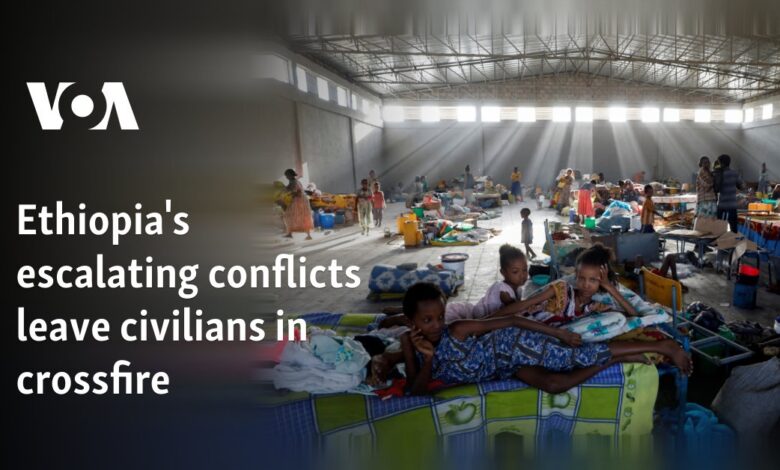Ethiopia’s escalating conflicts leave civilians in crossfire

Ethiopia, home to the African Union, is grappling with intensified military operations, rebel attacks, drone strikes on villages, unverified reports of beheadings, abductions, school and hospital closures, and growing calls for peace — all unfolding simultaneously.
On November 5, residents of the town of Gojam in the Amhara region were enjoying a quiet day when they heard a drone overhead. In quick succession, they said, the drone dropped bombs on a market and a health center. Locals said more than 40 people were killed.
One resident told VOA’s Horn of Africa Service that the bomb that hit the health center landed on a waiting room for pregnant mothers. “It hit that room and killed five mothers and two assistants. Seven people died in that single room,” he said.
Locals blame the attack on the federal government, which has been fighting Fano rebels in the region, though the government denies responsibility.
The incident underscored the chaos and violence that have engulfed much of Ethiopia despite promises of peace from Prime Minister Abiy Ahmed when he took power in 2018. Abiy brought a formal end to the country’s long-running conflict with Eritrea, but his time in office has been marked by ethnically driven conflicts in the Oromia, Tigray and Amhara regions, resulting in the deaths of hundreds of thousands and the displacement of millions.
A country divided internally
The conflict in the Oromia region began when the Oromo Liberation Army, or OLA, refused to disarm and split from the Oromo Liberation Front, or OLF, which had returned from neighboring Eritrea after Abiy came to power. The OLA claims it is fighting for the self-determination and rights of the Oromo people.
This conflict was followed by a two-year war in the Tigray region, which ended with a 2022 Cessation of Hostilities Agreement concluded in Pretoria.
In the Amhara region, the conflict has been ongoing since April last year, after the government attempted to disarm regional paramilitary forces. That sparked resistance from the Fano militias, who had previously allied with the government during the brutal war in Tigray.
Clashes between Ethiopia’s army and Fano militias surged in October, according to the independent data collecting organization Armed Conflict Location and Event Data Project, or ACLED, which said drone strikes in the Amhara region have resulted in over 430 fatalities since April 2023.
The Office of the U.N. High Commissioner for Human Rights said human rights abuses affected more than 8,200 victims in Ahmara and Oromia in 2023, a 56% increase over the year before. It accused state actors of responsibility for most of the incidents.
The rights office also said the use of drones by the Ethiopian National Defense Force resulted in disproportionate levels of civilian casualties.
The OLA is also blamed for deadly attacks, including an incident last week in which nine civilians were rounded up and killed in Arsi Zone of Oromia region. The OLA denied attacking civilians.
Ethiopian Communications Service Minister Legesse Tulu denied that the government is targeting civilians, saying its actions have been falsely portrayed by media outlets that weren’t identified. In a statement, Legesse said the government’s actions against “the extremist forces” in the Amhara region were “measured and planned.”
U.S. Secretary of State Antony Blinken spoke by phone with Abiy last month, expressing concern about the “growing violence” in the region.
Targeting of civilians denied
In August 2023, Ethiopia declared a state of emergency in the Amhara region, which is home to around 23 million people. All parties involved in the conflict have been accused of human rights violations, though each has denied responsibility.
Many schools in Amhara have been closed, leaving millions of children without education. On September 18, two teachers were killed in Sinan district of East Gojam, causing fear and concern among local educators.
The regional administration, without naming specific groups, accused armed factions “claiming to represent the Amhara people” of being responsible for the killings.
Fano militias have also been accused of killing civilians in the Oromia region, where two attacks in June and July left a total of 39 civilians dead. They were also accused in the deaths of a judge and other civilian officials in Amhara.
Eskinder Nega, a former journalist, an activist and now one of the leaders of the Fano militia, denied that the group targets civilians.
“Of course not,” he said in an interview with VOA last week. “We are fighting the government because civilians were attacked.”
Eskinder acknowledged that there are multiple factions of the Fano militia operating in the Amhara region. When asked about the group’s justification for closing schools and opposing their reopening, he said it was for the safety of students and the community.
Ethiopian officials, including Legesse, did not respond to repeated VOA requests for comment regarding the interview with the Fano official.
An independent Ethiopian analyst, speaking on condition of anonymity because of safety concerns, said the conflict in the Oromia and Amhara regions was becoming more intense and complex.
“The government mainly controls cities and towns, while the rural areas are contested by insurgents and pro-government forces,” he said. “The government’s strategy remains the same in both regions: using its military and local police to eliminate the insurgency. The OLA has remained fairly cohesive until recently. Fano, however, is highly fragmented.”
Mixed results
On the fifth anniversary of his Prosperity Party’s foundation last week, Abiy reiterated his call for rebels to engage in peace talks.
“As I have repeatedly stated, our brothers in the Amhara and Oromia regions will not defeat us, even if they fight for a thousand years. They will not bring about change, no matter how many times they rise and fall. I once again call on them, at this esteemed conference, to abandon that path and seek peace,” he said.
Just hours after his remarks, the Oromia regional government signed a peace agreement with Jaal Segni Negassa, a renegade commander of the Oromo Liberation Army who broke ties with OLA’s overall commander, Jaal Marroo.
OLA official Jiregna Gudeta dismissed the peace agreement, saying it was made with individuals who had been “expelled” from the organization.
In the Amhara region, the Fano militia group also rejected the government’s peace efforts, calling them “insincere.”
Government officials “believe in a military victory. Unless they change their approach fundamentally, it’s very difficult to take them seriously when they speak about peace,” Eskinder said.
This story originated in VOA’s Horn of Africa Service.




